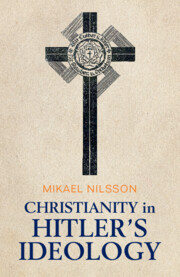Refine search
Actions for selected content:
59 results
1 - German-Soviet Relations and Military Collaboration in the Inter-war Period
- from Part I - Conceptions of War
-
-
- Book:
- The Cambridge Companion to the Nazi-Soviet War
- Published online:
- 13 November 2025
- Print publication:
- 20 November 2025, pp 9-26
-
- Chapter
- Export citation
3 - Stalin’s Political Delusions and Military Preparations for War with Nazi Germany
- from Part I - Conceptions of War
-
-
- Book:
- The Cambridge Companion to the Nazi-Soviet War
- Published online:
- 13 November 2025
- Print publication:
- 20 November 2025, pp 45-64
-
- Chapter
- Export citation
7 - Operation Barbarossa, 1941
- from Part III - Campaigns
-
-
- Book:
- The Cambridge Companion to the Nazi-Soviet War
- Published online:
- 13 November 2025
- Print publication:
- 20 November 2025, pp 119-136
-
- Chapter
- Export citation
10 - Munich 1938
- from Part III - The Twentieth Century through World War II
-
- Book:
- Crises, War, and Diplomacy
- Published online:
- 07 November 2025
- Print publication:
- 20 November 2025, pp 187-209
-
- Chapter
- Export citation

The Cambridge Companion to the Nazi-Soviet War
-
- Published online:
- 13 November 2025
- Print publication:
- 20 November 2025
The indictments against Adolf Hitler, their endorsement by the UNWCC, the IMT judgment and a twenty-first century immunity myth
-
- Journal:
- Leiden Journal of International Law , First View
- Published online by Cambridge University Press:
- 06 October 2025, pp. 1-24
-
- Article
-
- You have access
- Open access
- HTML
- Export citation
Chapter 2 - Diego Rivera’s Antifascist Art
-
-
- Book:
- Antifascism(s) in Latin America and the Caribbean
- Published online:
- 21 July 2025
- Print publication:
- 07 August 2025, pp 41-71
-
- Chapter
- Export citation
5 - Fascism and Holocaust
-
-
- Book:
- The Cambridge History of the Holocaust
- Published online:
- 16 May 2025
- Print publication:
- 12 June 2025, pp 93-112
-
- Chapter
- Export citation
15 - Hitler and the Nazi Party
-
-
- Book:
- The Cambridge History of the Holocaust
- Published online:
- 16 May 2025
- Print publication:
- 12 June 2025, pp 309-327
-
- Chapter
- Export citation
1 - Hitler, the Nazi Leadership, and the Evolution of the “Final Solution”
- from Part I - Structures, Players, and Processes
-
-
- Book:
- The Cambridge History of the Holocaust
- Published online:
- 21 May 2025
- Print publication:
- 12 June 2025, pp 27-50
-
- Chapter
- Export citation
6 - Greater Berlin
-
- Book:
- Berlin
- Published online:
- 13 February 2025
- Print publication:
- 30 January 2025, pp 109-133
-
- Chapter
- Export citation

Christianity in Hitler's Ideology
- The Role of Jesus in National Socialism
-
- Published online:
- 31 August 2024
- Print publication:
- 27 June 2024
3 - Christ on the Crooked Cross, Part II
-
- Book:
- Christianity in Hitler's Ideology
- Published online:
- 31 August 2024
- Print publication:
- 27 June 2024, pp 134-159
-
- Chapter
- Export citation
Conclusion
-
- Book:
- Christianity in Hitler's Ideology
- Published online:
- 31 August 2024
- Print publication:
- 27 June 2024, pp 234-242
-
- Chapter
- Export citation
1 - Christ on the Crooked Cross, Part I
-
- Book:
- Christianity in Hitler's Ideology
- Published online:
- 31 August 2024
- Print publication:
- 27 June 2024, pp 32-84
-
- Chapter
- Export citation
5 - Jesus as an Ideological Inspiration for Hitler and the NSDAP
-
- Book:
- Christianity in Hitler's Ideology
- Published online:
- 31 August 2024
- Print publication:
- 27 June 2024, pp 180-233
-
- Chapter
- Export citation
Introduction
-
- Book:
- Christianity in Hitler's Ideology
- Published online:
- 31 August 2024
- Print publication:
- 27 June 2024, pp 1-31
-
- Chapter
- Export citation
4 - Hitler’s Damascus Road Experience
-
- Book:
- Christianity in Hitler's Ideology
- Published online:
- 31 August 2024
- Print publication:
- 27 June 2024, pp 160-179
-
- Chapter
- Export citation
2 - Hitler’s Religious Teachers
-
- Book:
- Christianity in Hitler's Ideology
- Published online:
- 31 August 2024
- Print publication:
- 27 June 2024, pp 85-133
-
- Chapter
- Export citation
Myth 20 - That Hitler Endorsed and Was Influenced by Darwin’s Theory
-
-
- Book:
- Darwin Mythology
- Published online:
- 30 May 2024
- Print publication:
- 06 June 2024, pp 228-238
-
- Chapter
- Export citation
